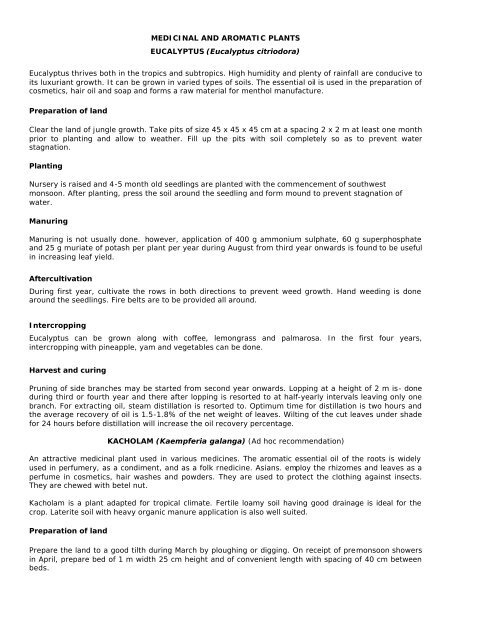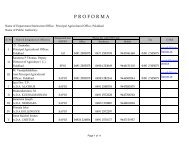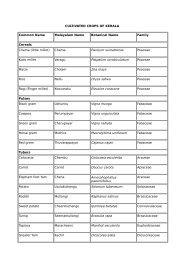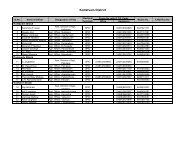Eucalyptus citriodora - kerala agriculture
Eucalyptus citriodora - kerala agriculture
Eucalyptus citriodora - kerala agriculture
You also want an ePaper? Increase the reach of your titles
YUMPU automatically turns print PDFs into web optimized ePapers that Google loves.
MEDICINAL AND AROMATIC PLANTS<br />
EUCALYPTUS (<strong>Eucalyptus</strong> <strong>citriodora</strong>)<br />
<strong>Eucalyptus</strong> thrives both in the tropics and subtropics. High humidity and plenty of rainfall are conducive to<br />
its luxuriant growth. It can be grown in varied types of soils. The essential oil is used in the preparation of<br />
cosmetics, hair oil and soap and forms a raw material for menthol manufacture.<br />
Preparation of land<br />
Clear the land of jungle growth. Take pits of size 45 x 45 x 45 cm at a spacing 2 x 2 m at least one month<br />
prior to planting and allow to weather. Fill up the pits with soil completely so as to prevent water<br />
stagnation.<br />
Planting<br />
Nursery is raised and 4-5 month old seedlings are planted with the commencement of southwest<br />
monsoon. After planting, press the soil around the seedling and form mound to prevent stagnation of<br />
water.<br />
Manuring<br />
Manuring is not usually done. however, application of 400 g ammonium sulphate, 60 g superphosphate<br />
and 25 g muriate of potash per plant per year during August from third year onwards is found to be useful<br />
in increasing leaf yield.<br />
Aftercultivation<br />
During first year, cultivate the rows in both directions to prevent weed growth. Hand weeding is done<br />
around the seedlings. Fire belts are to be provided all around.<br />
Intercropping<br />
<strong>Eucalyptus</strong> can be grown along with coffee, lemongrass and palmarosa. In the first four years,<br />
intercropping with pineapple, yam and vegetables can be done.<br />
Harvest and curing<br />
Pruning of side branches may be started from second year onwards. Lopping at a height of 2 m is- done<br />
during third or fourth year and there after lopping is resorted to at half-yearly intervals leaving only one<br />
branch. For extracting oil, steam distillation is resorted to. Optimum time for distillation is two hours and<br />
the average recovery of oil is 1.5-1.8% of the net weight of leaves. Wilting of the cut leaves under shade<br />
for 24 hours before distillation will increase the oil recovery percentage.<br />
KACHOLAM (Kaempferia galanga) (Ad hoc recommendation)<br />
An attractive medicinal plant used in various medicines. The aromatic essential oil of the roots is widely<br />
used in perfumery, as a condiment, and as a folk rnedicine. Asians. employ the rhizomes and leaves as a<br />
perfume in cosmetics, hair washes and powders. They are used to protect the clothing against insects.<br />
They are chewed with betel nut.<br />
Kacholam is a plant adapted for tropical climate. Fertile loamy soil having good drainage is ideal for the<br />
crop. Laterite soil with heavy organic manure application is also well suited.<br />
Preparation of land<br />
Prepare the land to a good tilth during March by ploughing or digging. On receipt of premonsoon showers<br />
in April, prepare bed of 1 m width 25 cm height and of convenient length with spacing of 40 cm between<br />
beds.
Seed materials<br />
Whole or split rhizome with at least one healthy sprout is the planting material in kacholam. Select well<br />
developed healthy and disease free rhizomes. Rhizomes can be stored in cool dry place or pits dug under<br />
shade, plastered with mud or cowdung. Two weeks before planting of the new crop, smoking the rhizomes<br />
by spreading it on Glycosmis pentaphylla ('panel') leaves is practised in certain localities.<br />
Varieties<br />
Mostly local varieties are under cultivation and they include collections from Koothattukulam, Thodupuzha,<br />
Varandarapalli, Kalladikode, Ponnukkara, Perumbavoor and Vellanikkara. Rajani and Kasthuri are newly<br />
released high yielding varieties with an yield potential of more than 2 tonnes dry rhizomes per ha and<br />
have good aroma and flavour.<br />
Season and method of planting<br />
Planting is done during the month of May with the receipt of four or five pre-monsoon showers. Take small<br />
pits in the beds in rows with a spacing of 20 x 15 cm and at a depth of 4-5 cm and plant rhizomes with at<br />
least one viable healthy bud facing upwards. Adopt seed rate of 700-800 kg/ha.<br />
Manuring<br />
Apply FYM or compost as basal dose at the rate of 20 t/ha, either by broadcasting and ploughing or by<br />
covering the rhizome in pits after planting. Apply N, P 2O 5 and K 2O @ 50, 50 and 50 kg/ha at the time of<br />
the first and second weeding.<br />
Mulching<br />
After planting, mulch the beds with dry or green leaves at the rate of 15 t/ha.<br />
After cultivation<br />
Remove weeds as and when necessary. Apply fertilizers and earth up the crop during the first and second<br />
weeding (45 and 90 days after planting). Avoid water stagnation in the beds. Further weeding will not be<br />
necessary because of the spreading of leaves on the soil surface in the beds.<br />
Plant protection<br />
During heavy rains, leaf rot disease occurs in certain localities. For controlling this disease, drench the<br />
beds with 1% Bordeaux mixture. Thiram 0.2% can also be sprayed.<br />
Harvesting and curing<br />
The crop can be harvested seven months after planting. Drying of the leaves is the indication of crop<br />
maturity for harvest. Harvest the, crop carefully without cutting the rhizomes, remove dried leaves and<br />
roots, wash the rhizome in water and dry. With sharp knife, chop the rhizomes into circular pieces of<br />
uniform size except the end portion, which has to be cut separately. Spread the cut rhizomes uniformly on<br />
clean floor and allow drying for four days. On fourth day, heap the rhizomes and keep it overnight. On the<br />
next day it is again spread and dried. Clean the dried produce, bag and store in cool dry place or market<br />
it. Prolonged storage can cause insect and fungus attack:<br />
LEMON GRASS (Cymbopogon Jlexuosus)<br />
Lemongrass prefers warm climate with a well-distributed rainfall and well-drained soil. Usually it is grown<br />
on poor, gravelly soils. Lemongrass is a perennial grass mainly cultivated on hill slopes as a rain fed crop.<br />
The crop provides maximum yield from the second to fourth year of planting and economic yield up to the<br />
sixth year. Thereafter, the yield declines considerably. The leaves yield an aromatic oil, containing<br />
70-90% citral. This oil is used in soaps, cosmetics and disinfectants and is a raw material for<br />
manufacturing ion ones and vitamin A.
Seeds and sowing<br />
The crop is propagated mostly through seeds. It can also be propagated vegetatively through planting of<br />
slips.<br />
OD-19 is the improved variety of lemongrass recommended for cultivation.<br />
Seeds can be sown directly in the field or seedlings are raised in a nursery and then transplanted.<br />
Transplanted crop is found superior to direct-sown crop in respect of grass yield, oil content and citral<br />
content in oil. Seeds are sown in well prepared nursery beds during April-May with the onset of premonsoon<br />
rains and covered with thin layer of soil. The seed rate is 3 to 4 kg/ha. Seeds collected in the<br />
season should be sown latest by August of the same year. The seedlings will be ready for transplanting in<br />
2 to 2.5 months.<br />
Preparation of land<br />
The land is prepared by digging. Raised beds of 75-80 cm width and of convenient length are formed with<br />
a spacing of 30-35 cm between beds. On sloppy terrain, the beds are formed along the contours. At the<br />
early southwest monsoon (June-July), two or three seedlings or slips per hill are transplanted on the beds<br />
at a spacing of 15-20 cm in 4-5 rows. Before planting, the top leafy portion of the seedling is cut off<br />
leaving the plant stalk about 15-20 cm length.<br />
Manuring<br />
Application of compost made of spent lemongrass (refuse obtained after distillation) and wood-ash at the<br />
rate of 2500 kg/ha and 1875 kg/ha respectively is found beneficial. Application of nitrogenous fertilizers @<br />
100 Kg/ha in four splits (each after 1st to 4th harvest) has been found to increase oil yield considerably.<br />
After cultivation<br />
Regular weeding depending on weed growth and earthing up at least once in a year along with manuring<br />
is recommended. Serious pests or diseases do not generally infest the crop.<br />
Harvesting<br />
Harvesting is done by cutting the grass 10 cm above ground level. During the first year of planting, three<br />
cuttings are obtained and subsequently five to six cuttings per year are taken subject to weather<br />
conditions. The harvesting season begins in May and continues till the end of January. The first harvest is<br />
taken about 90 days after planting and subsequent harvests at intervals of 4050 days. The optimum<br />
interval between harvests to obtain maximum quantity of oil is 40-45 days for local types of lemon grass.<br />
For OD-19, the optimum interval was found to be 60-65 days when grown in hill-tops and 45-55 days in<br />
valleys and lower areas.<br />
Seed collection<br />
The crop for seed production is left without cutting to get maximum seeds. The crop flowers during<br />
November-December and the seeds are collected during January-February. The whole panicle is cut and<br />
dried for one or two days and then threshed and sieved to collect the seeds.<br />
Distillation<br />
Lemongrass is distilled in copper stills of about 100 kg capacity by steam distillation, or water and steam<br />
distillation process. Time required for one distillation' is about two hours including the time required for<br />
charging and discharging, provided the firewood is well dried and of good quality. For one distillation,<br />
about 40 kg of firewood is required. A light yellow, lemon-scented volatile oil is obtained. Providing a<br />
perforated disc just above the water level in the copper still will be helpful to produce oil of better quality.<br />
This method is known as water and steam method. When crop area is large enough, steam method is<br />
found to be more economical. Coal is used as fuel.<br />
The cut grass is chopped into smaller pieces before feeding to the distillation unit. It can be stored up to 3<br />
days under shade without any adverse effect on yield or quality of oil.
Storage of oil<br />
Lemongrass oil can be stored up to 3 years without affecting the quality of oil, if kept in aluminum<br />
containers sealed air-tight using wax. The containers are to be kept in darkness.<br />
Yield<br />
The grass yield during the first year will be about 10 t/ha, which gives about 28 kg of oil. From the second<br />
year onwards, the grass yield will be about 25 t/ha giving about 75 kg of oil. The average recovery of oil is<br />
0.30-0.35% with 70% citral for local types of lemongrass while OD-19 variety gives O.4O-O.45% oil<br />
recovery and 85-90% citral content.<br />
PALMAROSA (Cymbopogon martinii var. mafia)<br />
Palmarosa (rosha grass) is adapted to marginal areas and poor soils; can be grown under dense canopies<br />
of trees and used for soil conservation.<br />
The flowering tops and foliage contain sweet smelling oil emitting a rose like odour and is widely used in<br />
soaps, cosmetics and perfumery industries. The oil is also used as a raw material for producing geraniol,<br />
which is extensively used in the perfumery industry.<br />
Propagation<br />
The crop can be propagated by seeds and slips. Seedlings establish quicker and are better than slips from<br />
clones. So seedlings are preferred. as planting materials under Kerala conditions. Prepare the seedbed in<br />
well-pulverized soil after 15th April. Four to five kg of seeds are sown in one hectare of land and covered<br />
with a thin layer of soil.<br />
Give frequent watering till the onset of southwest monsoon. Seeds collected in January-February must be<br />
sown latest by August.<br />
Planting<br />
Prepare the main field for planting form beds and plant the seedling, two on a hill, at a spacing of 30 x 20<br />
cm. Apply organic manures like compost made of spent grass and wood ash @ 6 t/ha and 2.5 t/ha respectively<br />
at the time of formation of beds.<br />
Harvesting<br />
By about 3.5 to 4 months, the plants attain a height of 150-200 cm and they start producing<br />
inflorescence. The grass is cut one week after flowering. Generally two cuttings are made during the first<br />
year of planting. From second year onwards 3 to 5 cuttings are possible.<br />
Distillation<br />
As in the case of lemongrass, extraction of palmarosa oil is done by the steam and water method. It takes<br />
two hours to complete one distillation. The average recovery of oil from Amaravathy variety if 0.40 to<br />
0.45%. Allowing the cut grass to wilt in shade for 24 hours during monsoon seasons and 48 hours during<br />
the post-monsoon will increase the oil recovery.<br />
Plant protection<br />
Pink globular root aphids CTetrcweura) occur -on the roots and cause' withering of the crop in patches due<br />
to de-sapping. Dig out and bum the affected patches and irrigate with water charged with fish oil soap or<br />
emulsion spray oil to control the aphids.<br />
VETIVER (Vetiveria zizanioides)<br />
Vetiver is a perennial grass, commonly known as 'khus' plant and mainly cultivated on hill slopes as a<br />
rainfed crop. The essential oil is extracted from the roots and known as 'khuskhus oil'.
It prefers a warm climate and grows in areas up to 600 m elevation. Even though vetiver grows almost in<br />
all soils, a rich and fairly well drained sandy loam is the best. An annual rainfall of about 100 to 200 cm,<br />
temperature ranging from 25 to 40°C and moderate humidity are ideal for its growth.<br />
Its root contains fragrant oil, which is a perfume by itself. The dry aromatic roots are made into curtains,<br />
mats, fans, etc. to emit scented cool aroma when moistened. The oil is used as a valuable fixative for<br />
blending perfumes and cosmetics.<br />
Varieties<br />
Two types of vetiver namely, South Indian and North Indian (khus) are generally under cultivation. South<br />
Indian types produce higher root and oil yield, but North Indian types have superior oil quality. Among the<br />
South Indian types, the Nilambur type (ODV-3) on an average produces 5 t/ha of root, yielding 20-30 kg<br />
oil/ha.<br />
Planting<br />
The crop is propagated through slips. June<br />
July is the optimum period for planting. Two to three ploughing are given so that the soil is well loosened<br />
and ridges or beds of convenient length are made. Slips are planted in two rows on 1 m wide beds.<br />
Manuring<br />
Usually 5 t/ha of FYM or compost is applied at the time of bed preparation. Application of 22.5 kg each of<br />
P 2O 5 and K 2O per ha is found to be beneficial for increasing root and oil yield.<br />
Harvesting and distillation<br />
The optimum period of harvest of roots to get the maximum oil yield is 18 months. Harvesting is done<br />
with the digging forks. The roots are washed gently to remove the earth and are chopped into bits of 4-5<br />
cm length. The oil is extracted by hydro-distillation.<br />
Vetiver as a soil binder<br />
Vetiver has a deep, dense and strong fibrous root system. The perennial and sterile characteristics of the<br />
crop with its hardiness and un-palatability to livestock make it an excellent soil-conserving crop. It may be<br />
planted as a contour hedge on sloppy lands or can be used to protect the banks of major irrigation canals.<br />
CHETHIKODUVELI [CITRAKA] (Pulmbago rosea) (Ad hoc recommendation)<br />
This is an attractive erect rambling shrub with long tuberous roots and bright red flowers in long terminal<br />
spikes. The root tubers are the medicinally important parts. This is an esteemed remedy for leucoderma<br />
and other skin diseases. The synonyms of fire like 'agnih' 'analah' etc. are attributed to this drug to<br />
indicate the caustic action of roots causing blisters on the skin. The drug is used only after adequate<br />
curing and purification. Roots contain plumbagin, which is responsible for the therapeutic action of the<br />
drug.<br />
Planting materials<br />
Propagated by single, double or three node semi-hard wood stem cuttings. Cuttings are planted in nursery<br />
beds of convenient length and I m width for rooting.<br />
Land preparation<br />
Prepare the land to a good tilth by ploughing two or three times. Make ridges of about 30 cm height and<br />
50 cm apart for planting rooted cuttings. Two to three month old rooted cuttings can be planted on the<br />
ridges at a spacing of 15 cm in June-July.<br />
Manuring<br />
Cattle manure or compost @ 10 t/ha may be applied as basal dose at the time of land preparation. The<br />
fertilizer dose for chethikoduveli is N:P 2O 5:K 2O 50:50:50 kg/ha. Entire P 2O 5 has to be applied as basal
dose and N and K 2O in two split doses, 2 months and 4 months after planting.<br />
Aftercultivation<br />
Weeding has to be done two or three times depending on weed growth. Earthing up may be done two<br />
times along with topdressing of fertilizers.<br />
Harvesting<br />
The crop can be harvested in about 18 months after planting. After digging out, the root tubers are<br />
cleaned by washing in water and marketed.<br />
NEELA AMARI [NEELI] (Indigo/era tinctoria)<br />
Nili is a reputed drug for the promotion of hair growth. Due to antitoxic property it is also a good remedy<br />
for poisons. This plant, which is the original source of natural indigo, is an erect shrub with imparipinnate<br />
leaves. Leaves are important in medicine and form a major ingredient of preparations like 'Nilibhringadi'.<br />
Land preparation<br />
Prepare the soil to fine tilth by ploughing two or three times.<br />
Seeds and sowing<br />
Seeds are very small and the seed rate is 3 kg/ha. Seeds require pretreatment for good germination, as<br />
the seed coat is hard. Seeds are mixed with sand and ground gently to break the seed coat. An alternate<br />
method for enhancing germination is dipping the seeds in boiling water for a second. After pre-treatment<br />
seeds are broadcasted. Broadcast the seeds preferably mixed with sand 2-3 times its volume to ensure<br />
uniform coverage. Seeds germinate within a week.<br />
Seasons<br />
The best time for sowing is September-October.<br />
Manuring<br />
Apply cattle manure at the rate of 10 t/ha as basal dressing and incorporate into soil along with last<br />
ploughing.<br />
Aftercultivation<br />
Weeding has to be done twice, three weeks and six weeks after sowing.<br />
Harvesting<br />
Plants start flowering 2-3 months after sowing. Harvesting is done by cutting the plants at this time, at a<br />
height of about 10 cm from ground level. Irrigate plants after harvest. Subsequent harvests can be made<br />
at 1.5-2 months interval. Four to five cuttings can be taken in a year depending on the growth.<br />
Seeds collection<br />
A few plants per plot are left without cutting to set seeds. Ripe pods are to be harvested in the early<br />
morning to prevent loss of seeds by shattering during harvest.<br />
Pests<br />
The psyllid Arytaina puctipennis infest top shoot causing curling up and drooping of leaves and shoots, and<br />
wilting of plants.
CHENGAZHINIRKIZHANGU (Kaempferia rotunda)<br />
Indian crocus, also known as bhucampaka in Sanskrit, abhuyicampa in Hindi and chengazhinirkizhangu in<br />
Malayalam is a medicinal herb with aromatic rhizome. The rhizomes are used for the treatment of tumours,<br />
swellings and wounds. It helps to remove blood clots and other purulent matters in body. It is<br />
used in many ayurvedic formulations including 'Chyavanaprasam' for improving complexion and curing<br />
burning sensation, gastric complaints, mental disorders and insomnia.<br />
Climate and soil<br />
The plant is distributed in the tropics and subtropics of Asia and Africa. It grows wild in wet, humid or<br />
shaded forest ecosystems of south India. It is also cultivated as an intercrop with other commercial crops.<br />
Moist loamy soil is ideal for the crop. Laterite soil with heavy organic manure application is also well<br />
suited.<br />
Propagation<br />
It is propagated through rhizomes and tissue culture methods.<br />
Varieties<br />
At present, only local types are available for cultivation.<br />
Season<br />
The optimum time of planting is with the receipt of four or five pre-monsoon showers in May-June.<br />
Land preparation<br />
Plough the field to good tilth. Incorporate organic manure at 10-15 t/ha. Prepare raised seedbeds of 1 m<br />
breadth and of convenient length.<br />
Seed rate<br />
Use rhizome bits of size 10-15 g for planting. About 2500-3000 kg rhizomes are required for planting one<br />
hectare. Smoking the rhizomes for 2-3 weeks is good for the development of healthy sprouts. At times.<br />
rhizomes are stored in Glycosmis pentaphylla leaves in underground pits covered with coconut fronds.<br />
Planting<br />
Pits are made at 20 cm spacing on the seedbed. Whole or split rhizomes with at least one healthy sprout<br />
is planted 5 cm deep with the sprout facing upwards and covering the pit with FYM.<br />
Mulching<br />
Mulch the beds thickly with green leaves or straw @ 15 t/ha immediately after planting and again after<br />
two months along with weeding and topdressing. Mulching is absolutely essential for good growth.<br />
Fertilizer application<br />
Fertilizer application can be skipped in fertile soils. In poor and marginal soils a moderate dose of<br />
50:50:50 N:P 2O 5:K 2O kg/ha U1ay be applied; P 2O 5 as basal and N & K 5O in two or three split doses.<br />
Aftercultivation<br />
Remove weeds, apply manure and fertilizers and earth up two and four months after planting, followed by<br />
mulching.
Plant protection<br />
During rainy months, rhizome rot is noticed which can be controlled by drenching 1% Bordeaux mixture.<br />
Harvesting and yield<br />
The crop matures in 7-8 months, Drying up of the leaves is the indication of maturity. Dig out the<br />
rhizomes carefully, remove leaves and clean. The rhizomes with attached tubers are usually marketed<br />
afresh. Prolonged storage may cause insect and fungus attack. The average yield is 12-15 t/ha and dry<br />
rhizome yield 27-30%.<br />
KASTHURIMANJAL (Curcuma aromatica)<br />
Curcuma aromatica known as vanharidra in Sanskrit jangali-haldi in Hindi and kasthurimanjal in<br />
Malayalam is a rhizomatous herbaceous medicinal plant. The rhizome is an odoriferous ingredient of the<br />
cosmetics used for the cure of chronic skin diseases caused by impure blood. It is used as appetizer and<br />
tonic to women after childbirth. It is also useful against high fever and worm infestation.<br />
Climate and soil<br />
It is distributed in Southeast Asia. The plant grows wild in the eastern Himalayas and in moist deciduous<br />
forests of Kerala and Karnataka. It is grown as a subsistence crop in backyard, kitchen garden and<br />
interspaces of other crops in areas with good rainfall. Well-drained rich loamy soils are ideal for the crop.<br />
Propagation<br />
It is propagated vegetatively by rhizomes and by tissue culture methods.<br />
Varieties<br />
At present, only local types are available for cultivation.<br />
Land preparation<br />
Clear the areas, remove all the pebbles and stones and plough the field to good tilth. Incorporate FYM or<br />
organic manure @ 10-15 t/ha. Prepare raised seedbeds of 1.2 m breadth and of convenient length. .<br />
Seed rate<br />
A healthy disease free mother rhizome with at least one germinated sprout is' the planting material. It is<br />
required at the rate of 1500 kg/ha.<br />
Planting<br />
Take small pits at 60 x 40 cm spacing on the seedbed find plant seed rhizomes with the germinating<br />
sprout facing upwards. Cover the rhizome with FYM and mulch the bed with leaves or straw. .<br />
Fertilizer application<br />
Apply fertilizers @ 100:50:50 N:P 20 5:K 5O kg/ha; entire P 2O 5 as basal and N and K 2O in two equal splits at<br />
planting and two months after planting.<br />
Aftercultivation<br />
Carry out gap filling if necessary within one month. Remove weeds two months after planting followed by<br />
topdressing, earthing up and mulching.<br />
Plant protection<br />
No serious pests and diseases are encountered in the crop.
Harvesting and yield<br />
The crop matures in 7 months. Drying up of leaves is the indication of maturity. Dig out the rhizomes<br />
without causing damage. Remove the dry leaves and roots. The cleaned rhizomes are either marketed Or<br />
dried and stored. The average yield of fresh rhizome is 28 t/ha which on drying gives 27% recovery.<br />
Processing<br />
The rhizome is thinly sliced and steam distilled for 3-4 hours for extracting the essential oil and the yield is<br />
90 litres per ha. Oil recovery is 0.33% on fresh weight basis and 1.05% on dry weight basis.<br />
CHITT ARA THA (Alpinia calcarata)<br />
Alpinia calcarata (galangal) is also known as rasna in Sanskrit, kulainjan in Hindi and chittaratha in<br />
Malayalam. It is a perennial herb with non-tuberous pungent rootstock. It grows to a height of 1.5 m and<br />
produces around 24 suckers per clump per year. The economic part is rhizome, which is a major<br />
constituent of many formulations of indigenous system of medicine for relieving throat inflammation,<br />
stimulating digestion, purifying blood, improving voice and marinating youthful vigour.<br />
Climate and soil<br />
Alpinia comes up well in tropical climate. It grows on a wide range of climate and soil. Well-drained hilly<br />
areas and places up to 1400 m altitude are good for its cultivation. Fertile red loams to forests soils are<br />
suitable.<br />
Propagation<br />
It is propagated vegetatively by rhizomes and by tissue culture methods.<br />
Varieties<br />
At present, only local types are available for cultivation.<br />
Season<br />
Rainfed crop is planted with the onset of monsoon in May-June. Irrigated crop can be planted at any time.<br />
Land preparation<br />
Plough the field to good tilth. Remove all pebbles and stones. Incorporate FYM or organic manure at 10-15<br />
t/ha. Prepare raised beds of convenient length and breadth to facilitate drainage.<br />
Seed rate<br />
Fresh healthy disease-free rhizome bits with at least one shoot is the planting material, which is required<br />
@ 1000-1500 kg/ha.<br />
Planting<br />
Take small pits on the seedbed and plant 5 cm long rhizome bits. Cover rhizome with FYM and mulch the<br />
seedbed with leaves or straw. The optimum spacing is 30 x 20 cm under good fertility and 40 x 30 cm<br />
under poor fertility conditions.<br />
Fertilizers application<br />
Apply fertilizers @ 100:50:50 N:P 2O 5:K 2O kg/ha per year in two or three split doses. Application of<br />
biofertilizer Azospirillum @ 10 kg/ha and in situ green manuring with cowpea are beneficial for the crop.<br />
Aftercultivation
Carry out gap filling, if required, within one month; remove weeds two months after planting followed by<br />
topdressing, earthing up and mulching. Thereafter no weeding is required as the crop smothers the<br />
weeds.<br />
Plant protection<br />
Usually pests and diseases are not serious enough to take up any control measures. Occasionally shoot<br />
borers and leaf eating caterpillars are observed which can be controlled by spraying 0.1 %<br />
monocrotophos. Blight disease can be controlled by spraying 1 % Bordeaux mixture.<br />
Harvesting and yield<br />
Though the crop can be harvested after 18 months, the optimum stage of harvest for obtaining maximum<br />
rhizome and oil yield is<br />
36-42 months after planting. Cut and remove the shoot portion and carefully dig out the rhizomes and<br />
roots. Harvesting is very arduous due to strong and extensive root ramification. Separate the roots, clean<br />
the rhizomes and cut into 5 cm long pieces, which are dried in the sun for 3-5 days to 10% moisture for<br />
marketing. The average yield of rhizomes is about 23 t/ha, which on drying gives 25% recovery.<br />
Processing<br />
The fresh rhizomes on steam distillation for 3-5 hours give 0.22% essential oil. The oil recovery on dry<br />
weight basis is 0.93%. Root is also a significant contributor of essential oil. .






